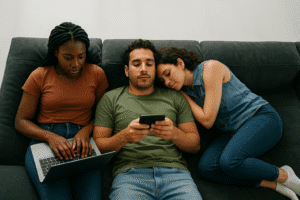
In this hyper-connected world, screens have become an integral part of our daily lives, whether it’s people doing their work on a laptop, browsing social media, watching shows in bulk, or taking online classes. Technology provides us with numerous benefits, but excessive screen
time can quietly affect our physical and mental well-being. From digital eye strain and posture
issues to mental fatigue, stress, and even disrupted sleep patterns, the consequences are real and becoming more and more prevalent. The longer we remain stuck on Screen Time, the longer we dismiss our body’s natural cues of rest and balance. If unabated, continuous exposure to devices can result in burnout, reduced productivity, and emotional depletion. Identifying these warning signs is the first step towards taking back control of your screen behaviors and your overall health.
Why Screen Time Is a Growing Concern:
 Nowadays people are spending too much time on screens, or else they have to work on the laptop or scroll social media, or children are watching videos and cartoons, but due to excessive use of screens, people are facing a lot of problems these days, like strain on eyes, headaches, or the effect of blue light is having more impact on the mental illness. Mentally, excessive screen time has been associated with decreased attention span, anxiety, and even depression. The relationship between screen time and mental well-being is particularly significant among adolescents and young adults, where pervasive digital engagement tends to result in emotional exhaustion.
Nowadays people are spending too much time on screens, or else they have to work on the laptop or scroll social media, or children are watching videos and cartoons, but due to excessive use of screens, people are facing a lot of problems these days, like strain on eyes, headaches, or the effect of blue light is having more impact on the mental illness. Mentally, excessive screen time has been associated with decreased attention span, anxiety, and even depression. The relationship between screen time and mental well-being is particularly significant among adolescents and young adults, where pervasive digital engagement tends to result in emotional exhaustion.
Signs you overuse screen time:
● Poor sleep
● Mood swings
● Focus difficulty
7 Signs You Need a Break from the Screen:
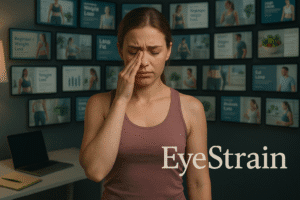 1. Burning or dry eyes:
1. Burning or dry eyes:
Eyestrain is the most frequent symptom of too much screen time. When your eyes are concentrated on something for a long time, your eyes start burning. If you’ve experienced pain in your eyes or particularly red eyes, the screens that you’re using might be the cause.
Solution: break from the screen and give rest to your eyes
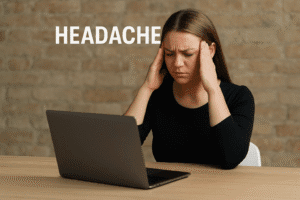 2. Frequent Headaches or Migraines:
2. Frequent Headaches or Migraines:
By spending too much screen time, we face problems like headaches or migraines, which usually cause eye strain. However, headaches also cause disturbance in sleep because many people use screen time late at night
Solution: Minimize screen headaches by employing blue light filters, breaks, hydration, and no screens before bedtime.
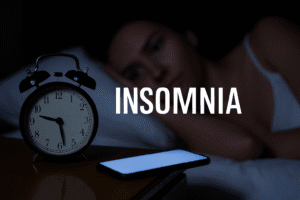 3. Trouble Falling or Staying Asleep:
3. Trouble Falling or Staying Asleep:
The blue light emitted by smartphones, tablets, and laptops represses melatonin, the hormone that governs your sleeping cycle. This can cause insomnia, frequent waking up, or restlessness despite a complete night’s sleep.
Solution: By using blue light filters or night mode on your screen. You can also avoid using the screen at a bad time.
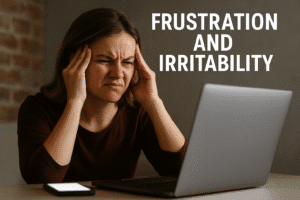 4. Irritability and frustration:
4. Irritability and frustration:
Continuous spending time on the screen can lead to feelings of frustration and irritability. If it is very important for you to work on the screen, then
manage the screen time and use the screen sparingly.
 5. Neck and Back Pain:
5. Neck and Back Pain:
Spending long hours on screen in the wrong posture can cause muscles to stiffen, which leads to neck and back pain ( tech pain).
Solution: By sitting in proper posture and taking a break every 20 to 60 minutes.
6. Losing interest in real-life activities:
Your phone and laptop are a primary reason to lose interest in social interaction, spending time with family and friends, and hobbies. This is a sign you are addicted to your screen.
Solution: By spending more time with your friends, interacting with people, and doing your hobbies.
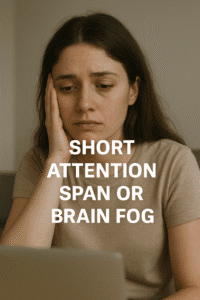 7. Short attention span or brain fog:
7. Short attention span or brain fog:
Sometimes we didn’t concentrate or think properly because of spending too much time on screens. You may find yourself daydreaming, forgetting things, or struggling to complete tasks. This is because your brain tires from repeatedly switching between apps, tabs, or messages.
Solution: Take a break every 30 to 60 minutes during which you don’t use the screen and stretch your muscles.
➢How to Reduce Screen Time Without Losing Productivity:
1. Use the 20-20-20 rule:
● 20-minute break: take a break every 20 minutes.
● Look at anything: look at any object that is 20 feet away from you.
● 20 seconds: look at that object for 20 seconds.
Repeat this every day if you are spending more time on screens.
2. Invest in blue light-blocking glasses:
Blue light effects are very harmful to your eyes. So, wearing blue light-blocking glasses can protect your eyes from screens.
CONCLUSION
In an era where digital devices dominate our personal and professional lives, it’s easy to
overlook the toll that excessive screen time takes on our health. From dry eyes and body
aches to mental fatigue and emotional detachment, the signs of screen overuse are often
subtle but serious.
The good news is that you don’t need to cut technology out of your life—you simply need
to use it more mindfully. By recognizing the warning signs and making small changes
like taking regular breaks, adjusting your posture, using blue light protection, and
carving out tech-free moments, you can protect your well-being without sacrificing
productivity.
Remember, screens are tools—not a way of life. Prioritizing balance today is an
investment in your mental clarity, physical comfort, and long-term health. Listen to
your body, protect your mind, and take back control of your screen time.

